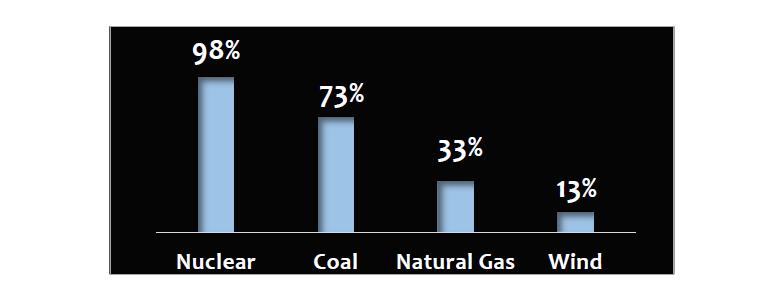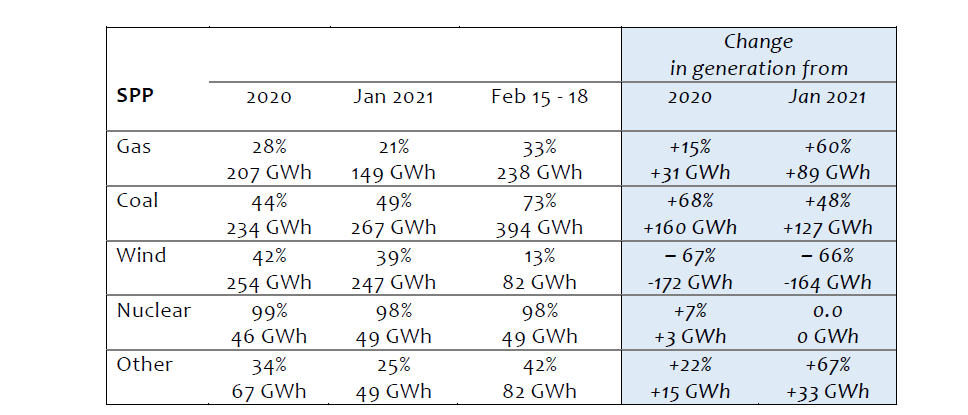During February 15-18, 2021, unusually cold weather interrupted the supply of electricity to customers in regions served by the Electric Reliability Council of Texas (ERCOT), the Midcontinent Independent System Operator (MISO), and the Southwest Power Pool (SPP). ERCOT was the most severely affected of the three regions (4 million customers lost power and at least 80 people died).1 SPP and MISO were forced to adopt less drastic emergency measures but still instituted rolling blackouts. This paper briefly analyzes the performance of gas, coal, nuclear, and wind in SPP and MISO during the four-day period. The analysis demonstrates the resilience of the coal fleets in MISO and SPP.
MISO
The MISO region has approximately 194,000 megawatts (MW) of installed electric generating capacity comprised of natural gas (79,000 MW or 41%), coal (57,000 MW or 29%), wind (25,000 MW or 13%), nuclear (13,000 MW or 7%), and various other sources (20,000 MW or 10%). Last year, the coal fleet generated 36% of MISO’s electricity, more than any other resource. However, almost 23,000 MW of MISO’s coal-fired generating capacity are scheduled to retire during this decade.
The coal fleet demonstrated its resilience during extreme weather by almost doubling its output (+92%) compared to last year and by producing almost half (49%) of MISO’s electricity during the four-day period. Below are some of the performance highlights of MISO’s electricity resources. Exhibits 1 and 2 follow the highlights.
- Coal responded well during the cold weather by increasing its electricity output by 92% compared to 2020. The capacity factor2 of the coal fleet increased from an average of 43% in 2020 to 84% during the extreme weather.
- Natural gas also increased its output relative to both 2020 and the previous month. However, due to gas supply disruptions and increased demand for heating, the capacity factor for natural gas was 40%, compared to 84% for coal.
- Wind’s capacity factor dropped to 17%, half that of the previous month (36% in January 2021) and 2020 (34%), and its output also dropped by almost half.
- Nuclear performed well, with a capacity factor of almost 90% during the extreme weather, similar to both the previous month and 2020.
- The output of other resources also increased, primarily due to the increased use of backup diesel and fuel oil generators that were necessary during the extreme weather.
Exhibit 1. MISO Capacity Factors During Feb 15-18

Exhibit 2. Capacity Factors (%) and Average Daily Generation (GWh)3

SPP
SPP’s approximately 91,000 MW of installed electric generating capacity is comprised of natural gas (34,000 MW or 37%), coal (24,000 MW or 26%), wind (23,000 MW or 25%), nuclear (2,000 MW or 2%), and other resources (8,000 MW or 9%). Some 8,800 MW of coal-fired generation have retired or have plans to retire. Last year, coal was the second largest producer of electricity (29%) in SPP behind wind (31%). During the extreme weather event, however, coal increased its output to provide 47% of SPP’s electricity. Other SPP highlights:
- The SPP coal fleet responded well by increasing its electricity output during the extreme weather to 68% above its output in 2020 and 48% above its January output. The capacity factor of the coal fleet increased to 73%, a considerable increase above its capacity factor last year of 44% and its January capacity factor of 49%.
- Natural gas increased its output by 15% above 2020 and 60% above the previous month. However, increased gas demand for heating as well as supply disruptions limited the capacity factor of natural gas to 33% during the extreme weather.
- The average capacity factor for wind dropped to 13%, down two-thirds from the previous month and from last year. Wind’s electricity output also declined by two-thirds.
- Nuclear’s capacity factor was 98%, similar to January and to 2020, which limited nuclear’s ability to increase its electricity output any more.
- The capacity factor of other resources also increased, due primarily to increased use of backup diesel and fuel oil generators that were necessary during the extreme weather.
Exhibit 3. SPP Capacity Factors During Feb 15-18

Exhibit 4. Capacity Factors (%) and Average Daily Generation (GWh)4

TAKEAWAYS
Fortunately, MISO and SPP had coal-fired generation to rely on during the extreme weather. However, further coal retirements will limit the ability of coal to respond to future resilience and reliability challenges.
Coal was able to increase its output and provide close to half the electricity in all or parts of the 21 states that comprise the MISO and SPP regions. This fact shows how important the coal fleet is when the electricity grid is faced with resilience challenges, in this case, extremely cold weather. The performance of the gas fleet was limited for reasons that typically affect gas in cold weather, and wind’s performance declined. The resilience of coal compared to gas and wind shows the importance of maintaining coal-fired generation even though the nation’s electricity mix is changing.
That said, we still believe the soundest energy strategy is one that includes coal, gas, nuclear, and renewables because each has its own advantages and disadvantages, especially in terms of maintaining a resilient and reliable electricity system.
1 See www.americaspower.org for our blog on ERCOT’s performance during the cold weather event.
2 Capacity factor is the percentage of actual electricity output over a given period of time to the maximum possible electricity output over that period.
3 Data are from EIA 860, EIA 923, and Hourly Electric Grid Monitor. “Other” includes a small amount of solar plus hydro, biomass, and petroleum products.
4 Data are from EIA 860, EIA 923, and Hourly Electric Grid Monitor. “Other” includes a tiny amount of solar generation (0.1%), along with hydro, biomass, and petroleum products.
